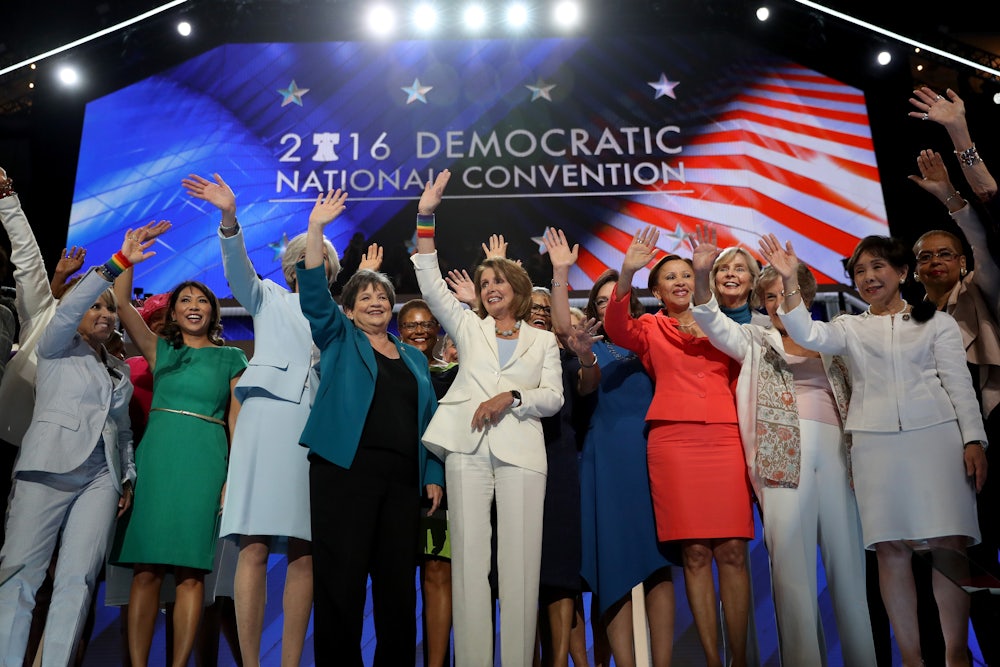
This past Election Day in Rochester, New York, hundreds of women made a pilgrimage to the cemetery where Susan B. Anthony was buried in 1906, 14 years before the Nineteenth Amendment was ratified. Many had brought their “I Voted” stickers, and plastered them all over her grave, confident that Hillary Clinton was about to shatter the “highest, hardest glass ceiling” she first invoked in her soaring concession to Barack Obama eight years earlier. That night, her supporters gathered at the Javits Center, a cavernous convention hall on the west side of Manhattan. It has a glass ceiling, too.
Instead, Clinton lost. She lost to a man with far less political experience, who was caught on tape boasting about his conquests. “Grab them by the pussy,” he said. “You can do anything.” America had given him license to do both. On Election Night, the news networks broadcast footage from Javits of women huddled together, others crying alone, all under that glass ceiling. Her defeat was more than a disappointment, more than a temporary setback—it was a stinging gut punch to millions of women around the country, a cruel reminder that no matter how much progress women have made since Seneca Falls, barriers are still barriers. What appeared within reach was suddenly cast far away: The country seems further than ever from electing a woman president, let alone achieving parity in the halls of American political power.
“Not only did we not break the glass ceiling this year, we actually made it higher,” said Jennifer Lawless, a government professor at American University who studies women in politics. “There was progress. We achieved a political milestone in Clinton being the nominee, and if she had lost to any candidate other than Donald Trump, someone who was not sexist, it would have been a different story. But this was the worse possible loss because of the content of his campaign. It undermined everything she stood for.”
Next year, it will have been exactly a century since Jeannette Rankin was sworn in as the first woman elected to Congress. But women will still hold less than 20 percent of the seats in the House and Senate—a figure that basically plateaued in the late 1990s. There will be fewer women in gubernatorial mansions than there were before Clinton ran for president. This year was supposed to be a turning point, the moment when, for the first time in 240 years, a woman would be elected to the White House. Instead, many women are now wondering whether they will ever see a woman president in their lifetimes. They bet everything on Clinton, and when she lost, it cast a light on how few female politicians are waiting in the wings to succeed her.
There will be only 104 women in both chambers in the 115th United States Congress, the same as this past year. If Nikki Haley is confirmed as ambassador to the United Nations, the number of women governors in the United States will drop from six in 2016 to four. The Center for Women and American Politics at Rutgers predicted that even with a few races still too close to call, there will be almost no growth for women in state legislatures. Most heartbreaking of all, this happened in a year when the number of women running for state legislatures had reached a record high. To Debbie Walsh, CWAP’s director, the numbers coming out of statehouses across the country are even more worrying than the national trends. “That is really the pipeline for women to serve in Congress,” she said. Without women in state legislatures, there’s no bench to pull from.
The one bright spot after the election was the news that the number of women of color in the Senate quadrupled—impressive, until you realize that it went from one to four, with the arrival of California’s Kamala Harris, Illinois’s Tammy Duckworth, and Nevada’s Catherine Cortez Masto, to join Hawaii’s Mazie Hirono. The United States currently ranks 99th on the list of countries with the most women elected to office. That puts it behind countries like the United Arab Emirates and Pakistan.
The problem is rooted in the thorny issue of political ambition. Research shows that women in the U.S. shy away from running for office because they are far more likely than men to doubt their qualifications and think that the electoral environment is competitive and biased. This, it turns out, is not the case. “The political landscape is as even as we’ve ever seen it,” said Lawless in a recent interview. (Last year, 92 percent of American voters said they would vote for a qualified woman if nominated by their party.) “But I’m worried the presidential race will reinforce the idea that women are treated with extreme hostility when they run because that was how Donald Trump treated Hillary Clinton.”
This may not be a problem in the short term. The Trump administration could galvanize women to run. It has happened before: In 1992, women were so angry after watching the Senate Judiciary Committee grill Anita Hill about Clarence Thomas that they ran for office in record numbers. Twenty-four women were elected to the House for the first time that year. Some early evidence suggests that anger could once again persuade women to run for office in the next few years. Rutgers University, for example, runs a series of workshops in March for prospective women candidates, called Ready to Run. By Christmas, they usually get about one or two paid registrations, but in the week after Donald Trump won the election, they were flooded: 80 women have already signed up, something that Walsh, the program’s director, says has never happened before.
While this anger may galvanize candidates who were interested in running in 2018 and 2020, it’s the next generation of candidates we should be concerned about: women who have not yet considered political bids. After this bitterly contested election, how do you convince a young woman to run for office? How can you persuade her that she would be equally likely as a man to win her race, when she saw Clinton lose to a sneering, misogynistic opponent? The trauma and disillusionment young women felt in seeing Clinton lose may, in the end, outweigh the temporary anger some felt watching him gear up for his inauguration. The trauma extends, after all, to more than 30 million women who voted for Clinton, and the thousands who knocked on doors, made phone calls, and fundraised for her campaign.
It’s hard to overcome that sense of loss and trauma without a new standard bearer, a leader who can tell the next generation, you too can rise all the way to the top. But this kind of trickle-down feminism may need to be reconsidered in the wake of Clinton’s loss. The problem is that there will soon be only four women governors and 21 senators left in the states and in Congress, respectively, names that people in politics may recognize but that are still relative unknowns on the national stage: Harris, Gillibrand, Warren, Klobuchar, Martinez. Those would be the best candidates to mount a bid for president four or eight years from now. Democrats will still be working hard to persuade women to join their ranks, but their narrative of women in politics that was years in the making—follow the leader and the rest will rise—will need to be rewritten.
